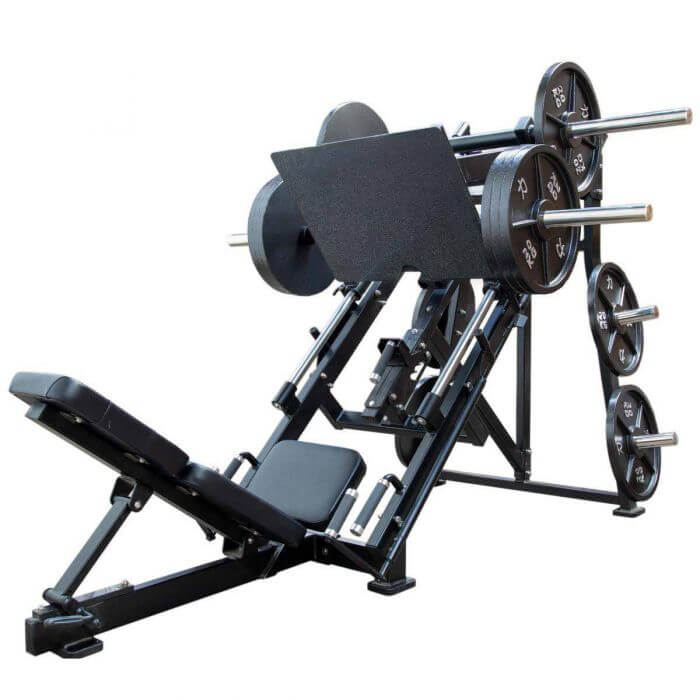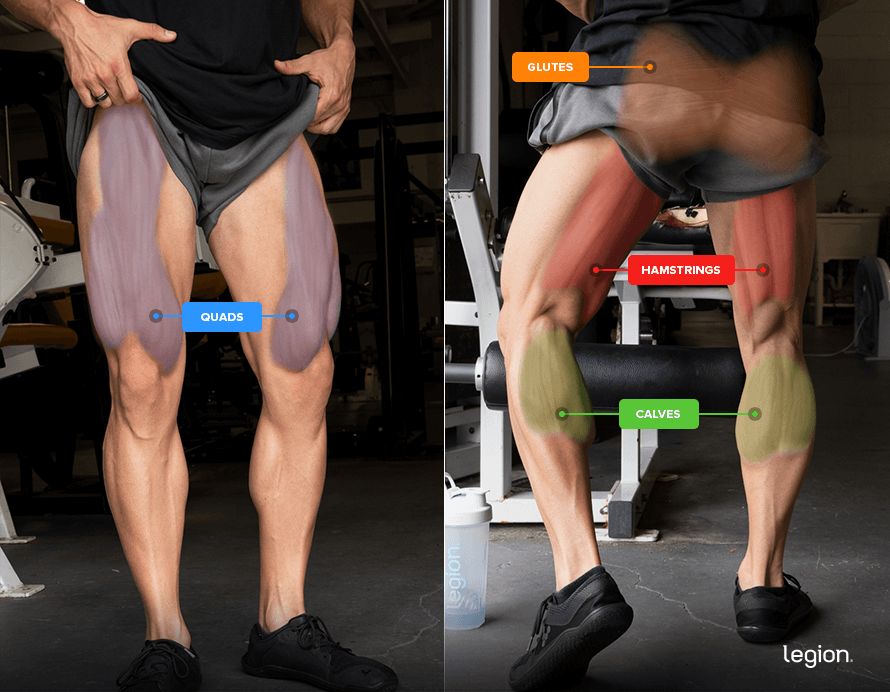How to Do the Leg Press: Benefits, Form, & Alternatives

According to many fitness “gurus,” all you have to do to build impressive legs is squat.
While there’s no denying the squat is an excellent leg exercise, is it really the be all and end all of leg training?
No.
One downside of the squat is that it’s highly fatiguing, especially for your lower back, which limits how much of it you can do per week before your joints cry uncle.
The best way to work around this issue is to do some squatting each week and also train your lower body muscles with other exercises that are gentler on your back, like the leg press.
The leg press trains many of the same muscles as the squat, but it isn’t nearly as fatiguing on your body as a whole, which means you can use it to continue training your legs, even when the rest of your body is too tired to squat safely.
Like any exercise, though, the leg press isn’t without risk, and if you want to get the most out of it while staying injury-free, you have to learn proper leg press form. (Ironically, it can even beat up your lower-back if you don’t do it properly).
In this article, you’ll learn everything you need to know about the leg press exercise, including what the leg press is, what the leg press benefits are, how to use the leg press machine with proper leg press form, and more!
- Table of Contents
- What Is the Leg Press?
- Leg Press: Muscle Worked
- Leg Press: Benefits
- 1. It allows you to train your legs when your back is tired.
- 2. It’s less fatiguing than other leg exercises.
- 3. It’s ideal for people with lower-back problems.
- Leg Press Foot Placement
- Leg Press: Form
- Step 1: Set up
- Step 2: Descend
- Step 3: Press
- FAQ #1: Leg Press vs. Squat: Which is better?
- FAQ #2: Leg Press vs. Hack Squat: Which Is Better?
- FAQ #3: What’s the best leg press workout?
- FAQ #4: What are the best leg press alternatives?
- FAQ #5: What’s the leg press world record?
- FAQ #6: Can you do the leg press at home?
What Is the Leg Press?
The leg press is a lower-body exercise that involves sitting in a seat and pushing a weight away from your body using your legs.
Typically, you perform the leg press using a machine called a “leg press machine” (some people also use the Smith machine to perform an exercise that’s similar to the leg press known as the “Smith machine leg press,” but this isn’t common).
Not all leg press machines are the same (the two most popular types of leg press machine are the “seated leg press” and the “vertical leg press”), but most consist of a padded seat, a footplate, and safety handles.
Here’s an example of what a leg press machine looks like:

Leg Press: Muscle Worked
One of the biggest benefits of the leg press exercise is that it trains all of your lower-body muscles, including the . . .
Here’s how the muscles worked in the leg press look on your body:

Leg Press: Benefits 1. It allows you to train your legs when your back is tired.
During many of the best leg exercises, like the back squat, front squat, and Romanian deadlift, your back muscles have to work hard to keep your upper body in a stable, safe, and efficient position.
If your leg workouts only consist of free-weight exercises like these, your back muscles (and particularly your lower-back muscles) may fatigue faster than your legs. In other words, while your back may be bushed after 6 sets of these exercises, your legs may be able to handle a few more.
The leg press is a helpful workaround in this scenario, as it allows you to train your legs (mainly your quads and glutes) after your back is fried.
This ensures you can train your legs with the volume they need to grow without your lower-back becoming a limiting factor.
2. It’s less fatiguing than other leg exercises.
Generally speaking, free-weight exercises are more effective than machine exercises for building muscle and gaining strength.
However, compound, free-weight exercises also tend to be more taxing on your joints, ligaments, tendons, and central nervous system than isolation, machine exercises that train the same muscles, which means you can only do so much before the quality of your workouts dips.
This is especially true when it comes to large muscle groups like the legs and back.
A good way to avoid this is to replace one of your free-weight leg exercises each week with the leg press exercise because this enables you to effectively train your legs without wearing your body to a frazzle.
For example, instead of doing a workout that consists of the barbell back squat, leg curl, barbell front squat, and dumbbell lunge, you could swap the front squat for the leg press. (In fact, this is almost exactly what Mike recommends in his programs for men and women.)
3. It’s ideal for people with lower-back problems.
Unlike many other compound leg exercises, the leg press doesn’t place any load on your spine when it’s performed correctly.
This makes it ideal for people who are training around or trying to avoid reaggravating a back injury.
That said, if you perform the leg press incorrectly by bringing your thighs too close to your chest, or if you lack the flexibility to perform it through a full range of motion, your lower back may round during the exercise.
This places stress on your lower back and may increase your risk of injury. Thus, it’s essential that you perform the exercise correctly, which you’ll learn how to do in a moment.
Leg Press Foot Placement
You may have heard that you can change which lower-body muscles you emphasize on the leg press by altering your leg press stance.
For example, common gymlore stipulates that . . .
- To do a leg press for glutes and hamstrings, you should place your feet high on the footplate.
- To do a leg press for quads, you should place your feet low on the footplate.
- To emphasize your outer quads, you should take a narrow stance.
- To emphasize your inner quads, you should take a wide stance and turn your toes out.
And while this isn’t completely wrong, it isn’t exactly right, either.
For instance, research shows that performing the leg press with your feet high on the footplate increases glute and hamstring activation, and performing it with your feet low on the footplate increases quad activation.
In both cases, however, the difference in activation is slight, and since higher muscle activation doesn’t always lead to more muscle gain, it isn’t clear how much changing the height of your leg press foot placement affects your long-term results.
Things are less ambiguous when it comes to how stance width and foot orientation affects muscle activation: several studies show that muscle activation in your legs is the same regardless of how wide your stance is or how you point your toes.
Thus, tinkering with your stance width on the leg press won’t make any difference to how much muscle you build or where you build it, though it’s still something you should experiment with to find a width that feels most comfortable for you.
All things considered, the best foot position for most people will be one that has your feet halfway up the footplate and a little wider than shoulder-width apart, and with your toes pointing slightly outward.
This is the most comfortable position for most people as it feels safe and stable and doesn’t require extreme flexibility, making it the best position to start with.
Leg Press: Form
The best way to learn how to use the leg press machine is to split the exercise into three parts: set up, descend, and press.
Step 1: Set up
Load a leg press machine with the desired amount of weight, then sit in the seat and wedge your butt down into the base of the seat.
Place your feet halfway up the footplate and a little wider than shoulder-width apart with your toes pointing slightly outward.
Straighten your knees slightly and use the safety handles to release the weight.
Step 2: Descend
Lower the footplate toward your chest until your knees are about 12-to-18 inches from your chest while keeping your butt firmly planted in the seat and without rounding your back.
As you lower the weight, push your knees out in the same direction as your toes.
Step 3: Press
While keeping your back pressed against the backrest, push the footplate away from your upper body until your legs are almost but not completely straight (knees slightly bent) and return to the starting position.
FAQ #1: Leg Press vs. Squat: Which is better?
It depends.
The leg press and squat are both effective exercises for training all the muscles of the legs, though the squat is likely better at training stabilizer muscles across your entire body and secondary muscle groups such as the lower back, and may have more carryover to other athletic endeavors.
That said, many people lack the mobility to perform the squat properly, or can’t perform the squat because of preexisting injuries that make it unsafe to place heavy loads on their back.
For these people, the leg press is a better option than the squat, at least until they develop the mobility to perform the squat with proper form or recover from the injury that makes squatting uncomfortable.
The squat is also very fatiguing, which can make the leg press a better exercise for including at the end of your workout when you’re feeling ragged.
FAQ #2: Leg Press vs. Hack Squat: Which Is Better?
It depends.
The main differences between the leg press and hack squat machines are that the hack squat trains your muscles through a greater range of motion, which is generally better for muscle growth, but the leg press is less taxing on your lower back, which means it’s less fatiguing and may be more comfortable if you’re working around a lower-back injury.
Of course, there’s no reason to choose just one. The best solution for most people is to include both exercises in your program.
A good way to do this is to include the leg press in your program for 8-to-10 weeks of training, take a deload, then replace the leg press with the hack squat for the following 8-to-10 weeks of training.
Then, you can either continue alternating between the exercises every few months like this or stick with the one you prefer.
FAQ #3: What’s the best leg press workout?
If you want to maximize muscle growth, research shows that it’s best to train your muscles in different ways, from different directions, and at different angles.
Thus, a proper “leg press workout” should also include other exercises that train your quads, hamstrings, glutes, and calves, like this:
- Barbell Back Squat: 3 sets of 4-to-6 reps with 2-to-3 min rest
- Romanian Deadlift: 3 sets of 8-to-10 reps with 2-to-3 min rest
- Leg Press: 3 sets of 8-to-10 reps with 2-to-3 min rest
- Seated Calf Raise: 3 sets of 8-to-10 reps with 2-to-3 min rest
FAQ #4: What are the best leg press alternatives?
The best leg press alternatives are free-weight exercises that use the same movement pattern as the leg press, such as the . . .
- Barbell back squat
- Barbell front squat
- Bulgarian split squat
- Lunge
- Step-up
If you aren’t able to do free-weight exercises, however, the next best leg press variation is the “one-leg leg press” (also known as the “single leg press”), which involves performing the leg press using one leg at a time.
The main benefits of the one-leg leg press are that it . . .
- Trains each leg independently, which is useful for identifying and evening out any muscle imbalances you might have
- Prevents you from rounding your back because one of your legs is placed on the floor, which means it’s useful if you’re training around a back injury
- Saves you time because you don’t have to load the leg press machine with as many plates to get an effective workout
One common leg press alternative I don’t recommend is the Smith machine leg press. It’s awkward to set up and perform, and it’s likely less effective than doing a Smith machine squat or lunge instead.
FAQ #5: What’s the leg press world record?
The leg press isn’t officially tracked in the same way that exercises like the squat, deadlift, and bench press are, which means there isn’t an official world record leg press.
That said, William Cannon set an unofficial leg press world record of 1,120 kilograms (2,470 pounds) for a single unaided rep using both legs in September 2021.
FAQ #6: Can you do the leg press at home?
Unless you have a leg press machine, no, you can’t do a “home leg press.”
That said, there are many good leg exercises you can do at home that train your legs in a similar way to the leg press.
Check out this article to learn some of the best leg exercises you can do at home with dumbbells, resistance bands, or your body weight:
The 3 Best Leg Workout Routines You Can Do at Home
The post How to Do the Leg Press: Benefits, Form, & Alternatives appeared first on Legion Athletics.




